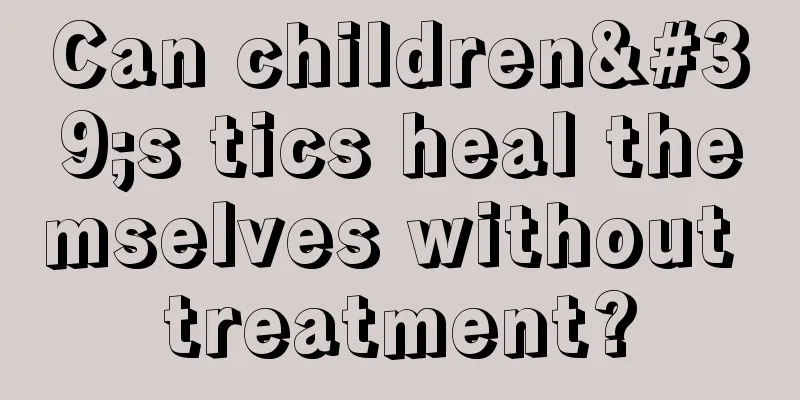What is the normal temperature of the baby's armpit?

|
It is the common wish of all parents that every child can grow up healthily. However, in the process of taking care of the baby, we find that taking care of the baby is not an easy task. The baby is relatively young and many emotions will be expressed through crying. However, once health problems occur, parents will always be particularly worried. This also requires parents to observe and care for the baby very carefully. Many parents find that the baby has a fever, but they don’t know what the baby’s normal body temperature is. Sometimes the baby’s fever will delay treatment. Let’s take a look at what is the normal armpit temperature for a baby. What is the normal temperature of the baby's armpit? When the baby's armpit temperature is above 37.5℃ or the rectal temperature or ear temperature is above 38℃, it can be determined that the baby has a fever. Fever is a physiological reaction of the baby's body and also a warning signal from the body. Since fever is a natural phenomenon of resisting the invasion of pathogens, if parents insist on reducing the baby's fever, it will weaken the baby's resistance. Generally speaking, if the baby's body temperature is around 38.5℃, and he is not feeling particularly uncomfortable and in good spirits, that is, he eats, sleeps and plays as usual, there is no need to rush to take the baby to the doctor or use antipyretics. You can drink appropriate amounts of water and use physical cooling methods. We do not advocate "covering up sweat" when the baby has a fever, as this will make it difficult for the heat to dissipate. Generally speaking, babies with high fever should not be covered with thick quilts and should wear fewer clothes. However, in order to reduce the baby's discomfort, parents should pay special attention to care. The baby should be allowed to get enough rest. Unless cramps may be caused by fever, it is not advisable to wake the baby in the middle of the night to take antipyretics; pay attention to the replenishment of water and electrolytes to avoid yellow urine. When the fever is around 38.5℃39℃, you can first take the following physical cooling methods at home. Antipyretics can be used moderately, with the principle of using one medicine at a time, to relieve the baby's discomfort and prevent the baby from having heat cramps. Apply ice or use an ice pillow. When the baby's body temperature is 38.5℃, put ice packs on the forehead, both sides of the neck, or on the armpits and both sides of the groin. To make a homemade ice pack, put crushed ice into a plastic bag, add appropriate amount of cold water, squeeze out the air, and tie the bag. Or you can let your baby sleep with an ice pillow, which can help the baby dissipate local heat and reduce fever. But be sure to wrap a layer of cloth around the ice bag to prevent local frostbite on the baby's skin. Generally, ice compresses and ice pillows are only suitable for older babies. For babies under 6 months old, you can use fever-reducing patches on the market to relieve the discomfort caused by high fever. Warm and wet compress is also a good method, that is, apply a large warm, wet, and semi-dry towel to the baby's chest and abdomen, but pay attention to the room temperature to avoid cold. In addition, you can also use a few slightly cool wet towels (about 25℃), wring them into half dry, and place them on the baby's forehead, neck, armpits and thighs for cold compresses. Change them every 57 minutes, and the baby will feel very comfortable. When the baby's body temperature rises above 38.5℃, use physical cooling to help the baby dissipate heat while also taking appropriate antipyretic drugs. If your baby refuses to take oral medications, antipyretic suppositories are the best choice. This suppository is inserted through the anus and is mainly absorbed by the rectum, so its effect is relatively fast. However, it should be noted that the use of antipyretic suppositories has a strong antipyretic effect and can easily reduce fever excessively, causing a sharp drop in body temperature. In addition, repeated stimulation of the anus by the drug can easily cause diarrhea in babies. For babies with high body temperature (above 39°C) and irritability, warm water baths (water temperature about 36°C to 37°C) and warm water sponge baths are the most appropriate ways to cool down. When taking a bath, immerse the baby's entire body (except the head) in water slightly lower than body temperature by 2°C. At the same time, use a warm and wet towel (37°C) to rub the baby's limbs, chest and back evenly to dilate the blood vessels on the skin surface to promote heat dissipation. Rub the limbs and back for 3 to 5 minutes each, and stay for a little longer in the armpits, groin and other areas with rich blood vessels. Take a bath for about 10 to 15 minutes each time, about once every 4 to 6 hours. The above is an introduction to the normal armpit temperature of a baby. I hope it will be helpful to many parents after understanding it. In addition, you must be particularly careful when taking care of your baby, because newborns generally have a higher body temperature. When taking care of your baby, do not let the baby wear too many clothes. Also, ensure that the indoor environment where the baby is located is ventilated. |
<<: What to do if baby's leg lines are asymmetrical
>>: How to make noodles for one-year-old baby
Recommend
Why does my baby have a fever and cold hands?
Children are naturally lively and active, but onc...
Preventing pneumonia in infants Breathing Healthy Diet and Lifestyle
Babies will have some diseases soon after they ar...
How to treat drooling in children with cerebral palsy
If a child with cerebral palsy drools, parents wi...
Reasons why children drool while sleeping
Nowadays, more and more young parents are at a lo...
What is the reason for black teeth in babies?
Many parents pay special attention to their baby&...
What causes swollen abdominal lymph nodes in children?
Because children have low body resistance, it is ...
What happens if a child has multiple swollen lymph nodes in the abdominal cavity?
Lymph nodes are organs distributed throughout the...
What should you pay attention to in your baby's diet after weaning?
Babies need to be weaned when they reach a certai...
What kind of honey is suitable for children
Children's growth and development is an issue...
Snacks for 2 year olds
In fact, the number of snacks for two-year-old ch...
What are the symptoms of chickenpox in children?
Although chickenpox is no longer a very scary dis...
The reason why babies suck their fingers, beware of improper feeding methods!
Many babies suck their fingers. There are many re...
What to do if your child refuses to grow taller
For parents, they certainly hope that their child...
What should I do if my child likes to sleep on his stomach?
I believe everyone knows the importance of sleepi...
What to do for a child's knee pain
Knee pain in children is not a normal phenomenon,...









